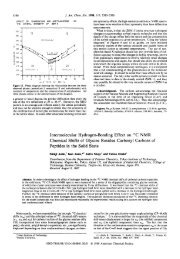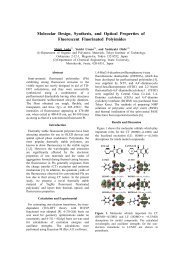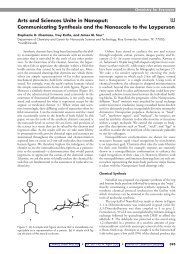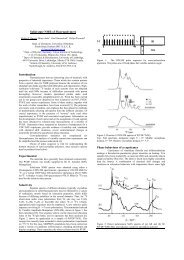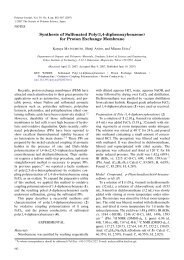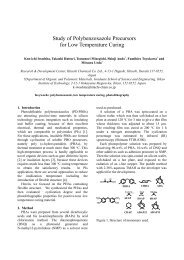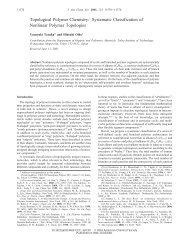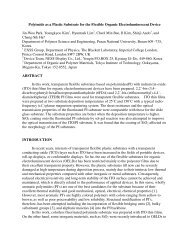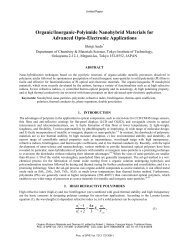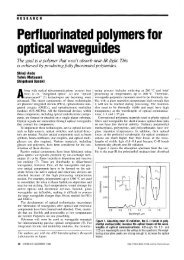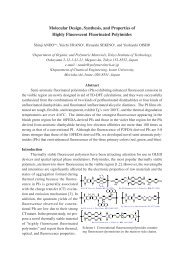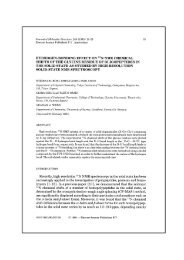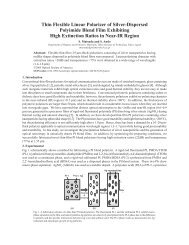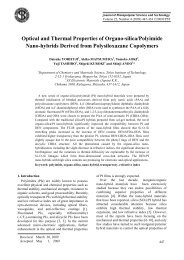Optical Properties of Fluorinated Polyimides and Their Applications ...
Optical Properties of Fluorinated Polyimides and Their Applications ...
Optical Properties of Fluorinated Polyimides and Their Applications ...
You also want an ePaper? Increase the reach of your titles
YUMPU automatically turns print PDFs into web optimized ePapers that Google loves.
all PI films, the absolute values <strong>of</strong> dn TE /dT are largerthan dn TM /dT, indicating remarkable anisotropy (dn TE /dT−dn TM /dT) in the TO coefficients in the range <strong>of</strong> −9 ~ −39 ppm/K. These anisotropy is not closely relatedto the degrees <strong>of</strong> refractive index or birefringence.This phenomenon may cause significant polarizationdependence in the performance <strong>of</strong> TOswitches, but this can also be used for polarizationsensitiveoptical filters or splitters etc.3 <strong>Applications</strong> <strong>of</strong> FPIs to <strong>Optical</strong> Use [34]3.1 Thin FPI-Film Substrates for MultilayerFiltersFlexible substrates for supporting “thin film filters”is a good example <strong>of</strong> the applications <strong>of</strong> outst<strong>and</strong>ingoptical transparency <strong>of</strong> FPI over the visible<strong>and</strong> NIR regions with good heat resistance, pliability,<strong>and</strong> good processability as thin films. For opticalcommunication applications, optical filters have afunction that they are transparent for specific wavelengthsbut reflective for other wavelengths. An opticalfilter consists <strong>of</strong> a dielectric multilayer, whichperforms transmission/reflection <strong>of</strong> light, <strong>and</strong> it isformed on a supporting substrate film. It is stronglyrequired that the thickness <strong>of</strong> a filter inserted into opticalcircuits, such as an optical fiber or opticalwaveguides, should be less than 20µm in order toreduce the radiation loss accompanying with a grooveformed in the optical circuits. For conventional bulktypefilters, multilayered thin film <strong>of</strong> TiO 2 <strong>and</strong> SiO 2is formed on an inorganic glass or silica substrate bysputtering, in which the cost for making thin film <strong>and</strong>grinding <strong>and</strong> polishing the substrate is rather high.On the other h<strong>and</strong>, since formation <strong>of</strong> FPI thin filmsis easy <strong>and</strong> economical by spin-coating [35], <strong>and</strong> theoptical transparency <strong>and</strong> heat resistance is excellent,FPI is the best material for substrates <strong>of</strong> multilayerfilters. Paying attention to the suitable properties <strong>of</strong>an FPI 7, thin film filters were fabricated using thisPI as a substrate. <strong>Optical</strong> filters having a function <strong>of</strong>1.3 µm-transmission / 1.55 µm-reflection were producedusing inorganic glass <strong>and</strong> FPI substrates, <strong>and</strong>almost the same properties were obtained. At present,thin PI film filters are produced <strong>and</strong> widely used inthe WDM modules for optical surveillance systemsin fiber-optics communications.3.2 Thin FPI-Film Waveplates“Thin film polyimide waveplate” is a good example<strong>of</strong> application using the large birefringence nature<strong>of</strong> FPIs having rigid-rod molecular structures withoutst<strong>and</strong>ing optical transparency. Silica-based planarlightwave circuits (PLCs) formed on Si substratesare widely used for optical communications becauseSpinCoatingDryingSolventPeelingPoly(amic acid)SolutionSubstratePoly(amic acid)FilmCuttingThermal Curing<strong>of</strong> their high performance <strong>and</strong> mass-productivity.However, the optical components using interference<strong>of</strong> light frequently show apparent polarization dependenceresulting from the birefringence <strong>of</strong> opticalwaveguides, <strong>and</strong> this had been a serious problem [36].As a technique for solving this, the polarization modeexchanging method which inserts a half-waveplate atthe center <strong>of</strong> optical path <strong>of</strong> PLC was proposed. However,when using a conventional half-waveplate madeby quartz (92 µm-thick), excess insertion loss (radiationloss) is more than 5 dB due to the large thickness.In order to reduce the loss, the thickness <strong>of</strong> awaveplate should be reduced, <strong>and</strong> thus, it is necessaryto produce a waveplate using highly birefringentmaterials. Moreover, ease at insertion, outst<strong>and</strong>ingoptical transparency at the operating wavelength, <strong>and</strong>high reliability over high temperature <strong>and</strong> high humidityare required as same as for optical filters. Andoet al. [37-40] focused on the rigid-rod molecule structure<strong>of</strong> a FPI 7. Although PI thin films can be easilyformed by spin-coating <strong>of</strong> polyamic acid solution (precursor)on a substrate followed by heating, the filmsthus produced is optically isotropic in the film plane.Hence, no in-plane birefringence (∆n // =∆n TE1 −∆n TE2 )is generated. Then, spin-coated polyamic acid solutionwas partially dried at a low temperature, <strong>and</strong>peeled from the substrate. The film was fixed to ametal frame by two sides <strong>of</strong> the longer direction. ThePI molecules are spontaneously orientated along thefixed direction during thermal imidization at 350°C,<strong>and</strong> thus large birefringence (∆n // =0.053) was generatedin the film plane. (Fig. 7). The magnitude <strong>of</strong>birefringence is controllable with high precision bychanging the curing conditions, in particular the highestimidization temperature. A PI waveplate exhibitinga large ∆n (0.18), that is 20 times larger than quartz,is producible by using this technique. As a result, thethickness <strong>of</strong> a novel PI waveplate <strong>of</strong> 14.5 µm for an TE2n TE1Metal FrameFig. 7 Method <strong>of</strong> preparing polyimide waveplate usingthe spontaneous orientation behavior [37-40].224



